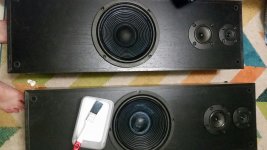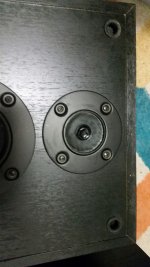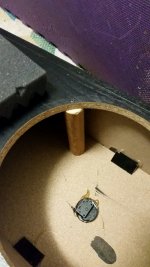Some great advice so far!
Personally, I dislike foam as better for higher frequencies. I prefer poly fill. It's about where it's placed and how much of it that's important. Poly fill is great fluffed up a bit after installing, with PVA is fine for anything to do with loudspeakers. I dislike placement on side walls, let the cabinet sound breath from the side walls and port only.
Bracing and selective placement of bitumen pads (used inside car doors to prevent vibration) this stuff is great on rear magnets and gives a stable sound and is great placed on rear wall, top and at times bottom.
I would replace the back wall with high quality plywood 18mm, cut 'picture frame' braces starting 1 third from the top of the cabinets. Experiment with wadding a bitumen. Get solid plates to sit on. Cheap poly cap on tweeter.
Brush sticks work better in threes in middle of panels yet picture frame braces are much better.
Rigid cabinets give great results
What sound do u want from them? What needs improving? Which music do you listen too?
Personally, I dislike foam as better for higher frequencies. I prefer poly fill. It's about where it's placed and how much of it that's important. Poly fill is great fluffed up a bit after installing, with PVA is fine for anything to do with loudspeakers. I dislike placement on side walls, let the cabinet sound breath from the side walls and port only.
Bracing and selective placement of bitumen pads (used inside car doors to prevent vibration) this stuff is great on rear magnets and gives a stable sound and is great placed on rear wall, top and at times bottom.
I would replace the back wall with high quality plywood 18mm, cut 'picture frame' braces starting 1 third from the top of the cabinets. Experiment with wadding a bitumen. Get solid plates to sit on. Cheap poly cap on tweeter.
Brush sticks work better in threes in middle of panels yet picture frame braces are much better.
Rigid cabinets give great results
What sound do u want from them? What needs improving? Which music do you listen too?
Last edited:
Hi Stewart,
Yeah some cool ideas coming through, thanks for contributing.
The speakers aren't for me but a friend and his family. They'll be getting used for general tv/music/movies/gaming. My friend already has a good dedicated set up for more serious listening so this is just for casual use. They already sound better than the tv alone obviously but a few mods to up the ante without dipping too deep in my pockets will be cool.
Yes I have my doubts about purely using foam, I might grab a couple of cheap pillows to use behind the woofers.
Yeah some cool ideas coming through, thanks for contributing.
The speakers aren't for me but a friend and his family. They'll be getting used for general tv/music/movies/gaming. My friend already has a good dedicated set up for more serious listening so this is just for casual use. They already sound better than the tv alone obviously but a few mods to up the ante without dipping too deep in my pockets will be cool.
Yes I have my doubts about purely using foam, I might grab a couple of cheap pillows to use behind the woofers.
You will learn a lot from tweaking them and will be fun.
I enjoy improving loudspeakers as much as I like building them from scratch
Yeah great idea on the pillows. Much better results than the foam. Foam is better than none yet deeper lows with poly fill.
Interested to see how you go. Do a 'knock' test on the walls to hear how bad factory cabinets sound. Although does not always benefit the sound making them more rigid. Worthy for what you want out of them
I enjoy improving loudspeakers as much as I like building them from scratch
Yeah great idea on the pillows. Much better results than the foam. Foam is better than none yet deeper lows with poly fill.
Interested to see how you go. Do a 'knock' test on the walls to hear how bad factory cabinets sound. Although does not always benefit the sound making them more rigid. Worthy for what you want out of them
I have used them, they are good for the price. You can also use electrolytics, they are better value for the price.Jaycar has some metal poly caps, not terribly expensive in the grand scheme of things but nearly the same price of the speaker to begin with
I wouldn't worry about lost volume. Anything less than 10% (even 20%) is probably negligible.
What I would probably do for a $25 speaker is just replace caps (might want to make sure the drivers are functioning before bothering ) and add foam and/or pillow stuffing - the bracing is a lot of work for a $25 speaker.
) and add foam and/or pillow stuffing - the bracing is a lot of work for a $25 speaker.
What I would probably do for a $25 speaker is just replace caps (might want to make sure the drivers are functioning before bothering
50/50 (ish) pva/water applied! I touched on the foam surrounds quite a bit (there was wine involved) hope this won't be detrimental?
One tweeter looks a little worse for wear, not just the dust cap but the cone itself. We'll see how they go, I didn't notice any tonal difference between left and right when playing.
Also found some of the speaker specs, seems it's rated at 88db, the tang band I have is 86db. I wonder if the woofer will drop down a little now that it's been treated?
https://www.sony.com.au/electronics/support/res/manuals/3860/38603251M.pdf
One tweeter looks a little worse for wear, not just the dust cap but the cone itself. We'll see how they go, I didn't notice any tonal difference between left and right when playing.
Also found some of the speaker specs, seems it's rated at 88db, the tang band I have is 86db. I wonder if the woofer will drop down a little now that it's been treated?
https://www.sony.com.au/electronics/support/res/manuals/3860/38603251M.pdf
Attachments
I imagine woodglue would hold the foam nicely.
It does.
Maybe one can wind coils oneself?
You mean the crossover coils? Or the voice coil? To wind the VC yourself needs extensive manual labor on the driver, including dissolving the glue of the surround, spider, dust-cap, spider-coil contact, VC wire on the VC former and precisely re-adjust and assemble, glue everything back in place. Some glue types can't be dissolved non-destructively or the contact materials are dissolved too.
Crossover coils can ofcourse be wound by DIY. Usually it's cheaper and the windings tighter (and much less effort) if you'd just buy one value over the needed inductance and unwind a few windings.
I forgot something: To swap coils to 'better' ones very likely does not improve the SQ! The serial resistance is part of the filter characteristics and that WILL change. In the bass it changes the Qt, so a lower resistance makes the deep bass thinner.
I have seen more than a few threads when caps replaced with "superior" ones actually produced poorer results, perhaps for similar reasons to what you mention but there are no inductors in this simple design. I'm inclined to give a better set of caps a go.
I have seen more than a few threads when caps replaced with "superior" ones actually produced poorer results, perhaps for similar reasons to what you mention but there are no inductors in this simple design. I'm inclined to give a better set of caps a go.
Yes, that can happen, usually it's worth changing the caps though. Better caps in series of the drivers very often give more clarity and resoluton. The caps parallel (to the - instead of the driver) change hardly anything.
They aren't expensive unless you buy high end caps from mundorf or other manufacturers, simple Monacor etc. foil capacitors are still so much better than the old electrolytic caps. See it this way: If it doesn't improve the sound as much as expected, you can reverse it and you have the capacitors ready for the next project.
Unfortune box geometry. Can you couple the woofer magnet to the back panel? Foam that recoils is not useful. Use fiberglass. Tap the panels to listen for resonance and glue cross braces over any sides that drum, especially directly behind the woofer. A choke on the woofer kills nasty high frequency cone resonances. Pads (resistors) on the mid and high bring them down where the woofer lives. Mids should have a choke too. There are free analyzers for your PC that are useful for such balancing. Even a cheap electrit mic is probably good enough. Imperfect accuracy is better than a shooting in the dark. Don't worry about not having an anechoic chamber because that's not where you listen to music. Ideally, you would measure the woofer T/S parameters and build a new box accordingly.
Try to get the lowest out of the midrange. If it doesn't distort at normal listening levels, then take it lower. Decide what values the capacitors need to be before you spend.I love the sweet spot of performance/frugality/efficiency.
Thanks for the suggestions guys, I'm taking them all in. I've not got much time on my hands over easter but I'll do what I can.
I think some bracing next and the woofer will be my main focus. I might look at one piece of broom handle from the magnet to the back of the cab, be a lot quicker than setting up for each screw hole.
I have a mic from my home cinema amp I could use for some basic information but I'm trying to avoid going too far down the rabbit hole with these (that's a habit of mine) there is something of a time constraint here too.
No fibreglass, I know it's good but I don't like the stuff.
I think some bracing next and the woofer will be my main focus. I might look at one piece of broom handle from the magnet to the back of the cab, be a lot quicker than setting up for each screw hole.
I have a mic from my home cinema amp I could use for some basic information but I'm trying to avoid going too far down the rabbit hole with these (that's a habit of mine) there is something of a time constraint here too.
No fibreglass, I know it's good but I don't like the stuff.
Well I've listened to one of the speakers after the pva treatment and it certainly seems less sibilant and perhaps a little clearer too, it's still coloured obviously but it's better than it was. A worthwhile mod.
The bracing is next and I was only able to cut and sand a few of these before swmbo told me it was too late for power tools but they'll be a nice snug fit. I'll go with the method mentioned earlier and put one under each woofer screw.
Would you guys try screwing it into the back wall too or is the glue enough?
Hoping to buy the stuffing and caps tomorrow
The bracing is next and I was only able to cut and sand a few of these before swmbo told me it was too late for power tools but they'll be a nice snug fit. I'll go with the method mentioned earlier and put one under each woofer screw.
Would you guys try screwing it into the back wall too or is the glue enough?
Hoping to buy the stuffing and caps tomorrow
Attachments
- Status
- This old topic is closed. If you want to reopen this topic, contact a moderator using the "Report Post" button.
- Home
- Loudspeakers
- Multi-Way
- Any threads on improving cheap speakers?


